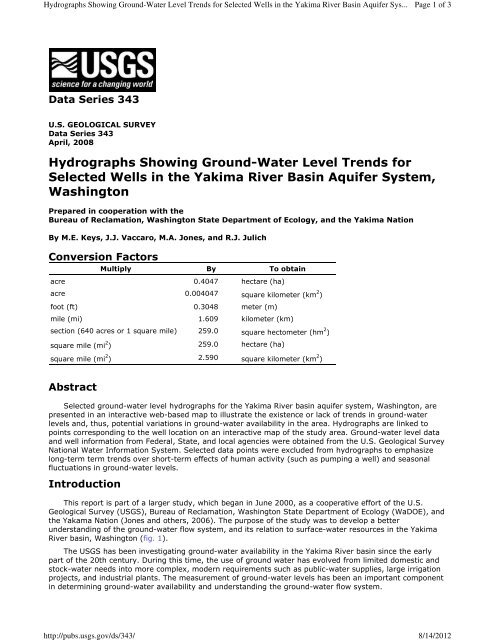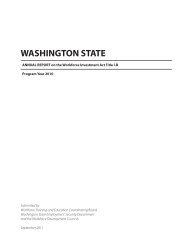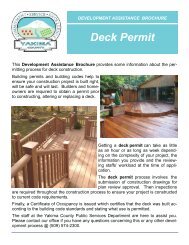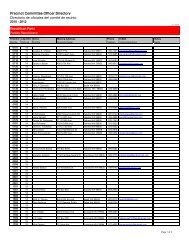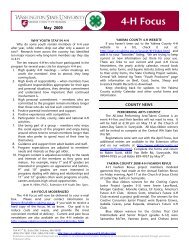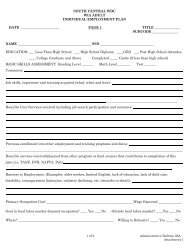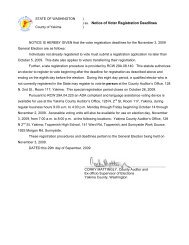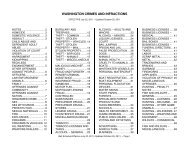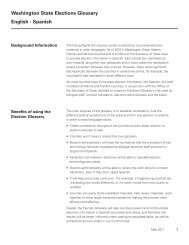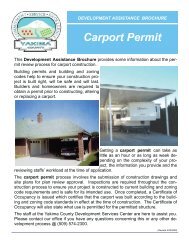Hydrographs Showing Ground-Water Level Trends ... - Yakima County
Hydrographs Showing Ground-Water Level Trends ... - Yakima County
Hydrographs Showing Ground-Water Level Trends ... - Yakima County
- No tags were found...
You also want an ePaper? Increase the reach of your titles
YUMPU automatically turns print PDFs into web optimized ePapers that Google loves.
<strong>Hydrographs</strong> <strong>Showing</strong> <strong>Ground</strong>-<strong>Water</strong> <strong>Level</strong> <strong>Trends</strong> for Selected Wells in the <strong>Yakima</strong> River Basin Aquifer Sys...http://pubs.usgs.gov/ds/343/Page 1 of 38/14/2012Data Series 343U.S. GEOLOGICAL SURVEYData Series 343April, 2008<strong>Hydrographs</strong> <strong>Showing</strong> <strong>Ground</strong>-<strong>Water</strong> <strong>Level</strong> <strong>Trends</strong> forSelected Wells in the <strong>Yakima</strong> River Basin Aquifer System,WashingtonPrepared in cooperation with theBureau of Reclamation, Washington State Department of Ecology, and the <strong>Yakima</strong> NationBy M.E. Keys, J.J. Vaccaro, M.A. Jones, and R.J. JulichConversion FactorsMultiply By To obtainacre 0.4047 hectare (ha)acre 0.004047 square kilometer (km 2 )foot (ft) 0.3048 meter (m)mile (mi) 1.609 kilometer (km)section (640 acres or 1 square mile) 259.0 square hectometer (hm 2 )square mile (mi 2 ) 259.0 hectare (ha)square mile (mi 2 ) 2.590 square kilometer (km 2 )AbstractSelected ground-water level hydrographs for the <strong>Yakima</strong> River basin aquifer system, Washington, arepresented in an interactive web-based map to illustrate the existence or lack of trends in ground-waterlevels and, thus, potential variations in ground-water availability in the area. <strong>Hydrographs</strong> are linked topoints corresponding to the well location on an interactive map of the study area. <strong>Ground</strong>-water level dataand well information from Federal, State, and local agencies were obtained from the U.S. Geological SurveyNational <strong>Water</strong> Information System. Selected data points were excluded from hydrographs to emphasizelong-term term trends over short-term effects of human activity (such as pumping a well) and seasonalfluctuations in ground-water levels.IntroductionThis report is part of a larger study, which began in June 2000, as a cooperative effort of the U.S.Geological Survey (USGS), Bureau of Reclamation, Washington State Department of Ecology (WaDOE), andthe Yakama Nation (Jones and others, 2006). The purpose of the study was to develop a betterunderstanding of the ground-water flow system, and its relation to surface-water resources in the <strong>Yakima</strong>River basin, Washington (fig. 1).The USGS has been investigating ground-water availability in the <strong>Yakima</strong> River basin since the earlypart of the 20th century. During this time, the use of ground water has evolved from limited domestic andstock-water needs into more complex, modern requirements such as public-water supplies, large irrigationprojects, and industrial plants. The measurement of ground-water levels has been an important componentin determining ground-water availability and understanding the ground-water flow system.
<strong>Hydrographs</strong> <strong>Showing</strong> <strong>Ground</strong>-<strong>Water</strong> <strong>Level</strong> <strong>Trends</strong> for Selected Wells in the <strong>Yakima</strong> River Basin Aquifer Sys...http://pubs.usgs.gov/ds/343/Page 2 of 38/14/2012Purpose and ScopeThis report presents more than 220 long-term hydrographs of wells in the <strong>Yakima</strong> River basin (Jonesand others, 2006). These hydrographs can be used as a general tool to identify potential water-levelvariations or trends and to understand how ground-water availability may be changing over time.Well-Numbering SystemThe USGS assigns numbers to wells and springs in Washington that identify their locations in atownship, range, and section (fig. 2). For example, given the well number 20N/15E-26N01, ‘20N/15E’indicates the township (20 N) and the range (15 E) north of the Willamette baseline and east of theWillamette meridian, respectively. The first number following the hyphen indicates the section number, 26,within the township (where townships are divided into 36 square-mile sections). The letter following thesection number, N, indicates the 40-acre subdivision of the section, as shown in figure 2, and the numberfollowing that letter, 01, is the sequence number of the well within the 40-acre subdivision. A ‘D1’ after thesequence number indicates that the original reported depth of the well has been changed; the numberindicates how many times the well depth has been changed. A ‘P1’ or an ‘A’ after the sequence numberindicates a group of nested piezometers, with successive numbers or letters assigned to each piezometer inthe group. An ‘R’ following the sequence number indicates that the well has been reconditioned. An ‘S’following the sequence number indicates that the site is a spring.<strong>Ground</strong>-<strong>Water</strong> <strong>Level</strong> Data and Well InformationThe USGS National <strong>Water</strong> Information System (NWIS) contains ground-water level measurement dataand well information for about 10,500 wells in the <strong>Yakima</strong> River basin. The water-level data represent acombination of USGS measurements and reported information from Federal, State, and local agencies, theYakama Nation, well drillers, and numerous private and public organizations. These data have beencollected and entered for a wide variety of projects and purposes over many years. Well information formany of these and other ground-water sites in Washington also is available from the WaDOE Well Logdatabase (Washington State Department of Ecology, 2003).Although NWIS has accurate information for many wells (especially those visited in recent studies),some problems are known to exist for older entries. Examples of these problems include, but are notlimited to, inaccurate well locations, outdated water usage information, and incorrect well-installation dates.Many wells in the database were not field visited, so information was entered into the database based onwell drillers’ reports and general location information; therefore, the resulting database varies in quality anddetail.Some water levels contained in NWIS for the <strong>Yakima</strong> River basin were input during the study thatbegan in June 2000. Data input during that study was obtained from (1) older USGS reports and fieldnotes, (2) USGS measurements made between 2000 and 2002, (3) the WaDOE, (4) the Bureau ofReclamation, and (5) the Yakama Nation.For this report, more than 220 <strong>Yakima</strong> River basin wells with water-level measurements spanning atleast 10 years were selected from NWIS for inclusion on the website. Some wells with shorter records alsowere selected to represent areas or hydrogeologic units where longer periods of record were not available.When possible, wells were selected that had been measured between the mid-1990s and early 2000s whenthe USGS, WaDOE, Bureau of Reclamation, and the Yakama Nation were making measurements. Wells alsowere selected to represent a reasonable spatial distribution for the aquifer system.Not all water-level measurements available in NWIS for a particular well may be presented on thehydrographs. For example, if most water levels for a given well were from spring months and only a fewwere from autumn, the autumn measurements were not included in order to emphasize the visual displayof long-term trends over seasonal fluctuations. Preference was given to water levels measured duringFebruary through May because they are less affected by human activities. Similarly, water-levelmeasurements made while the well was being pumped, as well as water-level measurements made soonafter pumping, generally were not included.Well <strong>Hydrographs</strong>Well locations are plotted on an interactive image of the study area using Google Maps(http://wa.water.usgs.gov/projects/yakimagw/hydrographs.htm). The image can be manipulated byclicking-and-dragging with the mouse to pan and double-clicking to zoom in. Alternatively, panning and
<strong>Hydrographs</strong> <strong>Showing</strong> <strong>Ground</strong>-<strong>Water</strong> <strong>Level</strong> <strong>Trends</strong> for Selected Wells in the <strong>Yakima</strong> River Basin Aquifer Sys...http://pubs.usgs.gov/ds/343/Page 3 of 38/14/2012zooming can be controlled with the buttons in the upper-left corner of the image. The user can hold thecursor over a well point to see a message box appear with the township-range number for that well, andclick on the point to see the corresponding hydrograph and selected well information.Each hydrograph is hyperlinked to a point on a map image corresponding to the well’s location. Foreach hydrograph, the well number, depth, and type of deposit in which the well is finished are indicated.The x-axis shows time and the y-axis shows depth-to-water, in feet below land surface. The y-axis isformatted with larger values on the bottom and smaller values on top, so the reader can visualize waterlevelsrising or declining along data points on the hydrographs. For example, if the depth-to-water valuesincrease over time for a given well, then, visually, successive data points move downward over time on thecorresponding hydrograph. Negative depth-to-water values indicate that the water level was above landsurface during that measurement. Such water levels may have been measured directly or inferred from awater-pressure reading.<strong>Ground</strong>-<strong>Water</strong> <strong>Level</strong> <strong>Trends</strong>The hydrograph periods of record vary, so the total decline or rise in water level over the period ofrecord may vary for wells with identical trends. For example, a well with a 20-year period of record of waterlevels showing a total decline of 80 feet indicates a declining trend of 4 feet per year. Likewise, a nearbywell in the same unit with a 50-year period of record might show a total water-level decline of 200 feet alsoindicating a declining trend of 4 feet per year.As can be seen by examining the hydrographs on the web site, rising, declining, and neutral trends inwater levels were evident for different regions and hydrogeologic units in the <strong>Yakima</strong> River basin aquifersystem. An improved understanding of human and natural factors controlling these water-level trends is aprimary objective for the larger <strong>Yakima</strong> River basin aquifer system investigation.AcknowledgmentsThe authors wish to thank the many municipal public-water suppliers, irrigators, and industrial wellowners for their cooperation in providing access to their records. The authors also thank the WashingtonState Department of Ecology (Central Regional Office) and the Yakama Nation who provided historicalmeasurements, without which the presentation of long-term hydrographs would not have been possible.References CitedJones, M.A., Vaccaro, J.J., and Watkins, A.M., 2006, Hydrogeologic framework of sedimentary deposits insix structural basins, <strong>Yakima</strong> River Basin, Washington: U.S. Geological Survey Scientific InvestigationsReport 2006-5116, 24 p., 6 pls.Washington State Department of Ecology, 2003, Well logs—Washington State well log viewer: WashingtonState Department of Ecology, accessed April 16, 2008, at http://apps.ecy.wa.gov/welllog/.Send questions or comments about this report to the first author, M.E. Keys, (253) 552-1699.For more information about USGS activities in Washington, visit the USGS Washington <strong>Water</strong> ScienceCenter home page.U.S. Department of the Interior | U.S. Geological SurveyURL: http://pubs.usgs.gov/ds/343Page Contact Information: Publications TeamPage Last Modified: Monday, 20-Dec-2010 17:30:53 EST


